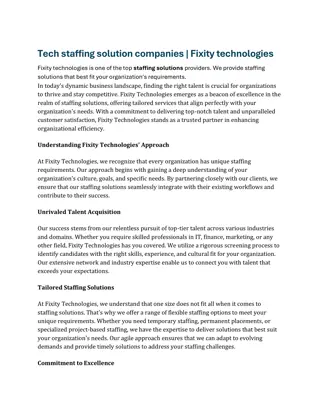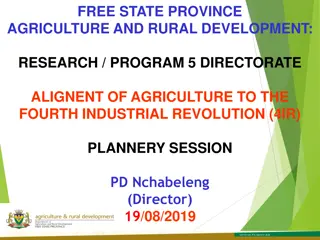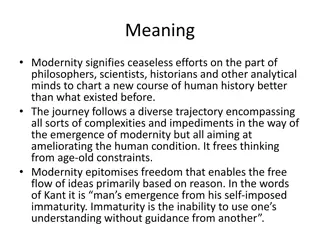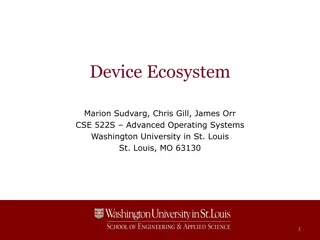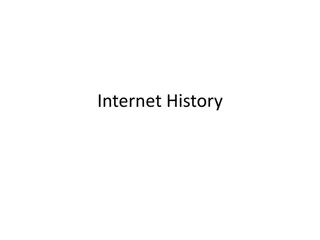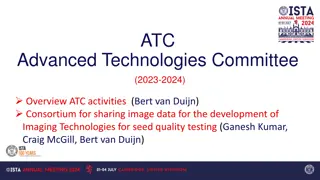Evolution of Technologies: A Journey Through Revolutions
Explore the evolution of technologies through different revolutions - from the agricultural revolution to the emerging technologies of the future. Learn about the profound changes in economic relationships and technological conditions that have shaped human society. Discover the role of data, programmable devices, and human-machine interaction in driving emerging technologies forward. Anticipate the smart revolution powered by new knowledge, ICT, and AI, shaping the society of the future.
Download Presentation

Please find below an Image/Link to download the presentation.
The content on the website is provided AS IS for your information and personal use only. It may not be sold, licensed, or shared on other websites without obtaining consent from the author. Download presentation by click this link. If you encounter any issues during the download, it is possible that the publisher has removed the file from their server.
E N D
Presentation Transcript
Chapter One Introduction to Emerging Technologies 2
1. Introduction to Emerging Technologies Topics Covered Evolution of Technologies Introduction to Industrial revolution Historical background (IR 1.0, IR 2.0, IR 3.0) Fourth industrial revolution (IR 4.0) Role of data for Emerging technologies Enabling devices and networks for Emerging Technologies (programmable devices) Human to Machine Interaction Future trends in Emerging Technologies 1-2 3
Introduction (1) Britannica dictionary defines Revolution as In social and political science, a major, sudden, and hence typically violent alteration in government and in related associations and structures . The term is used by analogy in such expressions as the Industrial Revolution, where it refers to a radical and profound change in economic relationships and technological conditions. 4
Introduction (2) We can see revolution is a radical and profound change in economic relationships and technological conditions. Therefore, we can divide revolution of technology profound change in our human being life into 4-steps such as : agriculture revolution (First revolution), industrial revolution (Second revolution), information revolution (Third revolution), and knowledge revolution (Fourth revolution) that will come in the future. 5
Introduction (3) Fourth revolution can also call as smart revolution because future s revolution will be smart society by new knowledge, ICT, AI, and etc. 6
Agriculture revolution Agriculture revolution was started from 1600. Human being make a life with a hunting, getting a catch fruit and vegetable, and others. This life style continues to agriculture and settles down at one place. This life style continues till first agriculture revolution. However, this life style of human being had been closed because the agricultural revolution was developed through plant and crop at one place. 7
Timeline of the Agricultural Revolution First agriculture revolution: The first agricultural revolution is the period of transition from a hunting-and-gathering society to one based on stationary farming. The technology developed for this period includes simple metal tools to cultivate the land. Second agriculture revolution: The second agricultural revolution went hand in hand with theIndustrial Revolution in the 18thand early 19th Century. New technology was introduced to agriculture for mass crop. Farmers were no longer to limited farms and commercial farming became an idea worth exploring. 8
The technology developed for this revolution includes the seed drill, which enabled farmers to easily plant rows, new fertilizers were also introduced as well as artificial feed. Third agriculture revolution: The green Revolution was the introduction of advanced technology and agricultural practices to farms to make farms more efficient. This revolution was sparked by the increasing awareness that the Earth is not renewable and that farms could not keep expanding outward and efficiency of land. 9
Fourth agriculture revolution: The current agriculture is changing because of AI and ICT. That is, AI and ICT is introducing to agriculture to analyze and to adjust humidity, temperature without weather condition. Current agriculture do not have competitiveness without recognition of customer s taste. 10
Industrial revolution (1) The industrial revolution took place during the late 1700s and early 1800s. The industrial revolution began in Great Britain and quickly spread throughout the world. This revolution affected social, cultural, and economic conditions. This revolution left a profound impact on how people lived and the way businesses operated as well as the creation of capitalism and the modern cities of today. 11
Industrial revolution (2) Industrialization was fast by the invention of new machinery and technology. James Watt s improvements to the steam engine and Boulton on the creation of the rotative engine were crucial for industrial production. Coal became a key factor in the success of industrialization. Improvements in mining technology ensured that more coal could be extracted to power the factories and run railway trains and steamships. 12
Information revolution (1) The information revolution started from invention of broad cast technology on 1922. Many information material could be stored on the device and was manipulated on computer networks. Their technology allow instant retrieval from anywhere in the world and storage at speeds. During this revolution, individuals can easily communicate with each other worldwide and share information by using the same computer networks 13
Information revolution (2) Information revolution was driven by three factors Firstly, information-based occupations grew throughout the 20th century. Almost office work dealt with information. Second , Cheap personal computers spread out information and materials with user-friendly operating systems. It enabled vastly more people to make direct and convenient use of computerized information. The third factor, it was the Internet that made a crucial contribution from the early 1990s. 14
Information revolution (3) The information revolution has already had major effects on both business and personal life. It allows many personal and business networks can be connected quickly by the Internet. People can communicate worldwide via e-mail and other Internet-based social network. Jobs have declined in such areas as banking, real estate, Also new professions and business have been created such as web designer, IT surviliace, contents, and etc 15
Information revolution (4) However, there are concerns over privacy and security to get over. The information revolution is still in its early stages. It will give an impact more on everywhere and its opportunities will emerge more in the 4th industrial revolution with AI, biotechnology, and etc. 16
The 4th Industrial revolution The Fourth Industrial Revolution describes the exponential changes to the way we live, work and relate to one another due to the adoption of cyber-physical systems, the Internet of Things (IoT), big data, AI (Artificial Intelligence), and its combined technologies. This revolution is expected to impact all disciplines, industries, social pattern, and economies. 17
The 4th Industrial revolution While in some ways it's an extension of computerization of the 3rd Industrial Revolution, due to the velocity, scope and systems impact of the changes of the fourth revolution. The Fourth Industrial Revolution is disrupting almost every industry in every country and creating massive change in a non-linear way at unprecedented speed. This revolution will give an impact bigger than the previous one to under developing or advanced country at the same time. The country that do not prepared will be merged socially and economically. 18
Role of data for emerging Technologies We are living in the age of big data. Data is regarded as the new oil and strategic asset, and drives or even determines the future of science, technology, the economy, and possibly everything in our world today and tomorrow. This reshaping and paradigm shifting is driven not just by data itself but all other aspects that could be created, transformed, understanding, exploring, and utilizing data. and/or adjusted by 19
Role of data for emerging Technologies (2) The preceding trend and its potential have triggered new debate about data intensive scientific discovery as a emerging technologies, the so-called fourth industrial revolution. There is no doubt, nevertheless, that the potential of data science and analytics to enable data-driven theory, economy, and professional development is increasingly being recognized. This involves not only core disciplines such as computing, informatics, and statistics, but also the broad-based fields of business, social science, and health/medical science. 20
Enabling device and networks for emerging technologies In the world of digital electronic systems, there are four basic kinds of devices: memory, microprocessors, logic and networks. Memory devices store random information such as the contents of a spreadsheet or database. Microprocessors execute software instructions to perform a wide variety of tasks such as running a word processing program or video game. Logic devices provide specific functions, including device-to-device interfacing, data communication, signal processing, data display, timing and control operations, and almost every other function a system must perform. 21
Programmable Logic Device Programmable logic Device refers to a general class of devices which can be configured to perform a variety of logic functions. Logic devices can be classified into two broad categories: 1. Fixed 2. Programmable 22
Fixed Logic Devices: As the name suggests, the circuits in a fixed logic device are permanent, they perform one function or set of functions - once manufactured, they cannot be changed. With fixed logic devices, the time required to go from design, to prototypes, to a final manufacturing run can take from several months to more than a year, depending on the complexity of the device. And, if the device does not work properly, or if the requirements change, a new design must be developed. 23
Programmable Logic Devices A programmable logic device(PLD) is an electronic component used to build reconfigurable digital circuits. Unlike a logic gate, which has a fixed function, a PLD has an undefined function at the time of manufacture. Before the PLD can be used in a circuit it must be programmed, that is, reconfigured by using a specialized program. Simple programmable logic devices (SPLD) are the simplest, smallest and least-expensive forms of programmable logic devices 24
Most SPLDs use either fuses or non-volatile memory cells (EPROM, EEPROM, FLASH, and others) to define the functionality. On the other hand PLDs are standard, off-the-shelf parts that offer customers a wide range of logic capacity, features, speed, and voltage characteristics - and these devices can be changed at any time to perform any number of functions. With programmable logic devices, designers use inexpensive software tools to quickly develop, simulate, and test their designs. Then, a design can be quickly programmed into a device, and immediately tested in a live circuit 25
The PLD that is used for this prototyping is exactly the same PLD that will be used in the final production of a piece of end equipment, such as A Network Router, A DSL Modem, A DVD player, or An automotive navigation system. 26
Another key benefit of using PLDs is that during the design phase customers can change the circuitry as often as they want until the design operates to their satisfaction That's because PLDs are based on rewriteable memory technology - to change the design, simply reprogram the device. Once the design is final, customers can go into immediate production by simply programming as many PLDs as they need with the final software design file. 27
Programmable Logic Devices (PLDs) are digital devices with configurable logic and flip-flops linked together with programmable interconnect. Logic devices provide specific functions, including: Device-to-device interfacing 1. Data communication 2. Signal processing 3. Data display 4. Timing 5. Control operations and almost every other function, a system must perform 28
Networking Computer networks are very essential to today's globalization as the world evolves to everything connecting in Information Technology. One of the key contributing factors of the Information Technology rise in the world is network and data communication because technology s advancement is not only on the gadgets but the system as well. 29
History of Computer Networks Networking started long ago by ARPANET. When Russia launched their SPUTNIK Satellite in Space in 1957. The American started an agency named Advance Research Project Agency (ARPA) and launched their 1st satellite within 18 month after establishment. Then sharing of the information in another computer they use ARPANET. Then in 1969, ARPANET comes in INDIA and INDIAN switched this name to NETWORK. 30
History of Computer Networks(2) Development of the network began in 1969, based on designs developed during the 1960s. The ARPANET evolved into the modern Internet. In the 1980s, the growth of client/server LAN architectures continued while that of mainframe computing environments declined. However, the biggest development in the area of LAN networking in the 1980s was the evolution and standardization of Ethernet. 31
History of Computer Networks(3) While the DIX consortium worked on standard Ethernet in the late 1970s, the IEEE began its Project 802 initiative, which aimed to develop a single, unified standard for all LANs. Also around 1985, increasing numbers of UNIX machines and LANs were connected to ARPANET, which until that time had been mainly a network of mainframe and minicomputer systems. 32
History of Computer Networks(4) In the 1980s, general or normal processors were used for networking process which was quite slow and took longer period to load. But later on the processor changed and now the networking processors are different and are made in such a way to boost the networking in any way possible. Back in the late 80s, they used specialized softwares to configure networks. It was then they started using Microsoft s Windows Server application. The latest is 2016 Server by Microsoft. 33
History of Computer Networks(5) The Security is a very important thing in networking world. Security purpose should be undertaken because without security, through networking one can hack through any information and alter the information for their own purpose. They used the network in the organization itself and used firewalls to prevent hackers from hacking. Nowadays there are a lot of security measures that can be chosen. The networking industries have evolved enormously from the late 1980s till today. The hardware have been upgraded and the software has changed a lot. 34
Future Trend of Networks With software trends emerging regularly in the IT scene, digital services and people are becoming further intertwined to characterize everything that s new the world of network technology. These recent advancements are more than likely to disrupt existing operations and foster an era of digitization and intelligence throughout the business sector. 35
Topics of future trends in networking technology 1. 5G technology: 5G technology serves to enhance not just the mobile device experience but communications tech environment. This will allow further development in such arenas as driverless cars. Imagine movies downloaded in a matter of seconds. Look for the fields communication and tactile feedback remote surgery, both of which require strong cellular support to unlock their full potential. Moreover, IoT gadgets are growing fast in almost all verticals, such as business, retail, homes, industries, and others. the entirety of the of vehicle to-vehicle 36
Topics of future trends in networking technology 5G could also provide extended bandwidths to make gaming or accessing social networks more exciting using wearable, devices that communicate with the network, are mobile, and have the ability to be easily transported by wearing them. Another promising application is no-touch computing, in which we can speak or direct our computers to perform without use of a mouse or keyboard. Expect to see a huge surge in the number of systems connecting to always-on 5G networks in the next few years. 37
Topics of future trends in networking technology 2. Network developments in edge computing Edge computing is one technological area that expanded greatly in the past few years. Combined with IoT and AI, it s led to innovative methods, like using AI to secure IoT systems. And that s not all: deep learning is being leveraged by datacenters to improve network speed and reduce the mass of transferred data at the edge of networks. 38
Topics of future trends in networking technology 3. Rise of decentralization Regular architectures directed traffic onto the datacenter for centralizing Internet access and security. However, greater collaboration between suppliers and partners and extensive cloud usage has disputed this model. The growth of direct cloud interconnection and cloud security services are encouraging many companies to adopt a decentralized approach for optimizing their connectivity to cloud platforms. 39
Topics of future trends in networking technology 4. Changing perspectives on ML and AI Machine learning(ML) and AI will continue to remain hot favorites among vendor marketing teams. Nearly all network devices are currently instrumented, transmitting telemetry to large data lakes. However our capacity to find true insights is still lacking. Like IoT, gathering data is easy, but it s more challenging to convert that data into usable insights. 40
Topics of future trends in networking technology 5. More attention to network security Network security is one of the key motivators for the rise of new IT services. With hackers and cybercriminals becoming more sophisticated, IT infrastructure is extending gradually into cloud-based, virtual platforms, leaving most client and company data exposed to security risks. 41
Topics of future trends in networking technology Network security is one of the key motivators for the rise of new IT services. With hackers and cybercriminals becoming more sophisticated, IT infrastructure is extending gradually into cloud-based, virtual platforms, leaving most client and company data exposed to security risks. 42
Topics of future trends in networking technology 6. Going wireless Advanced wireless technology as well as related security and management has led numerous companies to go wireless-first. Doing so eliminates the charges related to moves, additions and modifications to the fixed and wired LAN infrastructure. Moreover, it promises greater reliability and resilience. Cloud specific as-a-service advanced monitoring tools and features are being deployed as well to provide increased performance insight and visibility. deployments and 43
Topics of future trends in networking technology 7. Cloud repatriation Cloud repatriation is when apps move from the cloud back to on-premises. This indicates that datacenters have not lost their relevance yet. The majority of repatriation activity centers on businesses attempting to discover balance or equilibrium. This does not signify that the cloud is losing relevance; merely that is has been somewhat over-hyped. 44
Topics of future trends in networking technology 8. Smart automation expands Companies often spend huge amounts on network automation so they don t fall behind. Pointed solutions and manual scripting cannot scale to complement the considerable rise in network demands. The upcoming generation networks will feature machine learning and AI to ward off security challenges and network complexity. 45
Topics of future trends in networking technology 9. Networking technology: Keep up with the changes Communications and information technology are advancing rapidly and it is necessary for companies to consider which of the emerging technologies is ideal for their business. Implementing the right networking technology allows the organization to get the most benefits. 46
Human to Machine Interface(1) The Association for Computing Machinery (ACM) defines human computer interaction as "a discipline concerned with the implementation of interactive computing systems for human use and with the study of major phenomena surrounding them". An important facet of HCI is user satisfaction (or simply End User Computing Satisfaction). "Because human computer interaction studies a human and a machine in communication, it draw from supporting knowledge on both the machine and the human side. design, evaluation an 47
Human to Machine Interface(2) Due to the multidisciplinary nature of HCI, people with different backgrounds contribute to its success. HCI is also sometimes termed human machine interaction (HMI), man-machine interaction (MMI) or computer-human interaction (CHI). Humans interact with computers in many ways; the interface between humans and computers is crucial to facilitate this interaction. Desktop applications, internet browsers, handheld computers, and computer kiosks make use of the prevalent graphical user interfaces (GUI) of today. 48
Human to Machine Interface(3) HMI is all about how people and automated systems interact and communicate with each other. That has long ceased to be confined to just traditional machines in industry and now also relates to computers, digital systems or devices for the IoT. More and more devices are connected and automatically carry out tasks. Operating all of these machines, systems and devices needs to be intuitive and must not place excessive demands on users. 49
Human to Machine Interface(4) Smooth machines requires interfaces. The place where or action by which a user engages with the machine. Simple examples are light switches or the pedals and steering wheel in a car. However, a system can also be controlled by text being keyed in, a mouse, touch screens, voice or gestures. Voice user interfaces (VUI) are used for speech recognition and synthesizing systems. communication between people and 50



